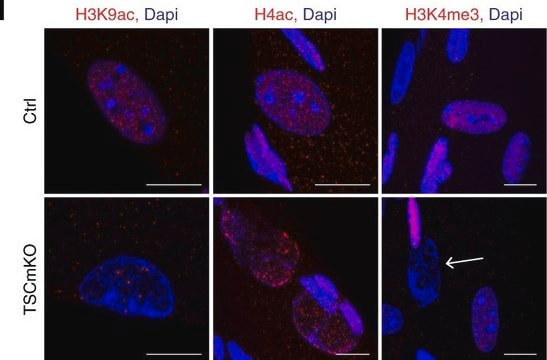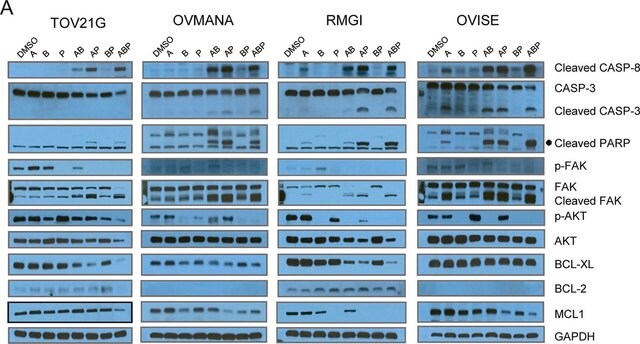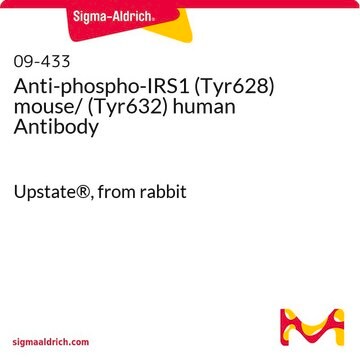17-229
Acetyl-Histone H4 Immunoprecipitation (ChIP) Assay Kit
Acetyl-Histone H4 Immunoprecipitation (ChIP) Assay Kit used to immunoprecipitate transcriptionally active chromatin from mammalian cells using anti-Acetyl-Histone H4, ChIP grade rabbit antiserum.
Sign Into View Organizational & Contract Pricing
All Photos(1)
About This Item
UNSPSC Code:
12161503
eCl@ss:
32161000
NACRES:
NA.52
Recommended Products
Quality Level
manufacturer/tradename
Upstate®
technique(s)
immunoprecipitation (IP): suitable
NCBI accession no.
UniProt accession no.
shipped in
dry ice
General description
For use to immunoprecipitate transcriptionally active chromatin from mammalian cells using anti-Acetyl-Histone H4, ChIP grade rabbit antiserum. Detection of the gene or promoter of interest in immunoprecipitated chromatin must be empirically determined by the researcher using quantitative PCR or Southern slot-blot analysis, using promotor specific primers or probe.
Application
Acetyl-Histone H4 Immunoprecipitation (ChIP) Assay Kit used to immunoprecipitate transcriptionally active chromatin from mammalian cells using anti-Acetyl-Histone H4, ChIP grade rabbit antiserum.
Packaging
Kit capacity: 22 assays
Components
Anti-acetyl-Histone H4 (Cat.# 06-866)
Protein A agarose/Salmon Sperm DNA (Cat.# 16-157)
All necessary buffers
Protein A agarose/Salmon Sperm DNA (Cat.# 16-157)
All necessary buffers
Legal Information
UPSTATE is a registered trademark of Merck KGaA, Darmstadt, Germany
Disclaimer
Unless otherwise stated in our catalog or other company documentation accompanying the product(s), our products are intended for research use only and are not to be used for any other purpose, which includes but is not limited to, unauthorized commercial uses, in vitro diagnostic uses, ex vivo or in vivo therapeutic uses or any type of consumption or application to humans or animals.
Signal Word
Warning
Hazard Statements
Precautionary Statements
Hazard Classifications
Aquatic Chronic 3 - Eye Irrit. 2
Storage Class Code
10 - Combustible liquids
Certificates of Analysis (COA)
Search for Certificates of Analysis (COA) by entering the products Lot/Batch Number. Lot and Batch Numbers can be found on a product’s label following the words ‘Lot’ or ‘Batch’.
Already Own This Product?
Find documentation for the products that you have recently purchased in the Document Library.
Guocheng He et al.
Molecular and cellular biology, 22(9), 2965-2973 (2002-04-10)
Repression of human immunodeficiency virus type 1 (HIV-1) transcription may contribute to the establishment or maintenance of proviral quiescence in infected CD4(+) cells. The host factors YY1 and LSF cooperatively recruit histone deacetylase 1 (HDAC1) to the HIV-1 long terminal
Lata Balakrishnan et al.
Journal of molecular biology, 365(1), 18-30 (2006-10-24)
SV40 chromosomes undergoing transcription operationally defined by the presence of RNA polymerase II (RNAPII) were immune-selected with antibody to RNAPII and subjected to secondary chromatin immunoprecipitation with antibodies to hyperacetylated or unacetylated H4 or H3. Immune selection fragmentation and immunoprecipitation
Shaojing Chang et al.
Journal of immunology (Baltimore, Md. : 1950), 181(12), 8372-8381 (2008-12-04)
Forming and removing epigenetic histone marks at gene loci are central processes in differentiation. Here, we explored mechanisms establishing long-range H4 acetylation marks at the Ifng locus during Th1 lineage commitment. In Th0 cells, histone deacetylase (HDAC)-Sin3A complexes recruited to
Priya Kapoor-Vazirani et al.
Cancer research, 68(16), 6810-6821 (2008-08-15)
Epigenetic silencing of tumor suppressor genes in human cancers is associated with aberrant methylation of promoter region CpG islands and local alterations in histone modifications. However, the mechanisms that drive these events remain unclear. Here, we establish an important role
Hui Liu et al.
Blood, 104(8), 2505-2513 (2004-07-01)
Cyclin D1 expression is deregulated by chromosome translocation in mantle cell lymphoma and a subset of multiple myeloma. The molecular mechanisms involved in long-distance gene deregulation remain obscure, although changes in acetylated histones and methylated CpG dinucleotides may be important.
Our team of scientists has experience in all areas of research including Life Science, Material Science, Chemical Synthesis, Chromatography, Analytical and many others.
Contact Technical Service









